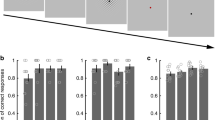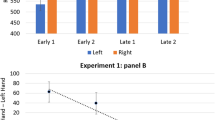Abstract
The anterior portion of the human insula is implicated in a wide range of tasks that involve judgements of short periods of time (a few seconds or less). However, it is only one of several brain regions that share this property. We review the evidence for its involvement and discuss the nature of the contribution it might make to time judgements. The anterior insula is frequently identified in functional MRI studies that require participants to generate a time interval to match an internal or external template, or to discriminate between the durations of two stimuli. It is involved in many different timing tasks and is active irrespective of the stimulus modality used to present the stimuli. However, the role of the anterior insula in timing remains uncertain. Indeed, rather few studies have attempted to distinguish different possible contributions. The fact that it is active in a variety of tasks suggests that it may be involved in some indirect or general way. For example, during time discrimination, the anterior insula may be concerned more with discrimination than with time, as it is sometimes also active during other discrimination tasks. Other structures may be more strongly associated with core timing functions.

Similar content being viewed by others
References
Augustine JR (1996) Circuitry and functional aspects of the insular lobe in primates including humans. Brain Res Rev 22:229–244
Billington J, Field D, Wilkie R, Wann J (2010) Sub-cortical processing of imminent collision in humans
Brunia CH, Damen EJ (1988) Distribution of slow brain potentials related to motor preparation and stimulus anticipation in a time estimation task. Electroencephalogr Clin Neurophysiol 69:234–243
Buhusi CV, Meck WH (2005) What makes us tick? Functional and neural mechanisms of interval timing. Nature Rev Neurosci 6:755–765
Bushara KO, Grafman J, Hallett M (2001) Neural correlates of auditory–visual stimulus onset asynchrony detection. J Neurosci 21:300–304
Calvert GA (2001) Crossmodal processing in the human brain: insights from functional neuroimaging studies. Cereb Cortex 11:1110–1123
Coull JT, Nobre AC (2008) Dissociating explicit timing from temporal expectation with fMRI. Curr Opin Neurobiol 18:137–144
Coull JT, Vidal F, Nazarian B, Macar F (2004) Functional anatomy of attentional modulation of time estimation. Science 303:1506–1508
Courtney SM, Ungerleider LJ, Kell K, Haxby JV (1997) Transient and sustained activity in a distributed neural system for human working memory. Nature 386:608–611
Craig AD (2008) Interoception and emotion: a neuroanatomical perspective. In: Lewis M, Haviland-Jones J, Barrett L (eds) Handbook of emotion, 3rd edn. Guilford, New York, pp 272–288
Craig AD (2009) Emotional moments across time: a possible neural basis for time perception in the anterior insula. Philoso Trans R Soc Lond B Biol Sci 364:1933–1942
Deary I, Simonotto E, Meyer M, Marshall A, Marshall I, Goddard N, Wardlaw J (2004) The functional anatomy of inspection time: an event-related fMRI study. Neuroimage 22:1466–1479
Downer J, Crawley A, Mikulisand D, Davis K (2000) A multimodal cortical network for the detection of changes in the sensory environment. Nat Neurosci 3:277–283
Droit-Volet S, Meck WH (2007) How emotions colour our perception of time. Trends Cogn Sci 11:504–513
Ferrandez AM, Hugueville L, Lehericy S, Poline JB, Marsault C, Pouthas V (2003) Basal ganglia and supplementary motor area subtend duration perception: an fMRI study. Neuroimage 19:1532–1544
Gandour J, Wong D, Lowe M, Dzemidzic M, Satthamnuwong N, Long Y, Luritoc J (2002) Neural circuitry underlying perception of duration depends on language experience. Brain Lang 83:268–290
Genovesio A, Tsujimoto S, Wise SP (2006) Neuronal activity related to elapsed time in prefrontal cortex. J Neurophysiol 95:3281–3285
Grahn JA, Brett M (2007) Rhythm and beat perception in motor areas of the brain. J Cogn Neurosci 19:893–906
Griffith TD, Rees A, Witton C, Cross PM, Shakir RA, Green GG (1997) Spatial and temporal auditory processing deficits following right hemisphere infarction: a psychophysical study. Brain 120:785–794
Harrington DL, Boyd LA, Mayer AR, Sheltraw DM, Lee RR, Huang M, Rao SM (2004) Neural representation of interval encoding and decision making. Cogn Brain Res 21:193–205
Hinton SC, Harrington DL, Binder JR, Durgerian S, Rao SM (2004) Neural systems supporting timing and chronometric counting: an fMRI study. Cogn Brain Res 21:183–192
Jantzen KJ, Steinberg FL, Kelso JAS (2004) Brain networks underlying human timing behaviour are influenced by prior context. Proc Natl Acad Sci USA 101:6815–6820
Jantzen KJ, Steinberg FL, Kelso JAS (2005) Functional MRI reveals the existence of modality and coordination-dependent timing networks. Neuroimage 25:1031–1042
Lejeune H, Maquet P, Bonnet M, Casini L, Ferrara A, Macar F, Pouthas V, Timsit-Berthier M, Vidal F (1997) The basic pattern of activation in motor and sensory temporal tasks: positron emission tomography data. Neurosci Lett 235:21–24
Leon MI, Shadlen MN (2003) Representation of time by neurons in the posterior parietal cortex of the macaque. Neuron 38:317–327
Lewis PA, Miall RC (2003a) Distinct systems for automatic and cognitively controlled time measurement: evidence from neuroimaging. Curr Opin Neurobiol 13:250–255
Lewis PA, Miall RC (2003b) Brain activation patterns during measurement of sub- and supra-second intervals. Neuropsychologia 41:1583–1592
Lewis PA, Miall RC (2006) A right hemispheric prefrontal system for cognitive time measurement. Behav Process 71:226–234
Livesey AS, Wall MB, Smith AT (2007) Time perception: manipulation of task difficulty dissociates clock functions from other cognitive demands. Neuropsychologia 45:321–331
Mauk MD, Buonomano DV (2004) The neural basis of temporal processing. Annu Rev Neurosci 27:307–340
Mita A, Mushiake H, Shima K, Matsuzaka Y, Tanji J (2009) Interval time coding by neurons in the presupplementary and supplementary motor areas. Nat Neurosci 12:502–507
Morillon B, Kell CA, Giraud A-L (2009) Three stages and four neural systems in time estimation. J Neurosci 29:14803–14811
Nelson SM, Dosenbach NUF, Cohen AL, Wheeler ME, Schlaggar BL, Petersen SE (2010) Role of the anterior insula in task-level control and focal attention. Brain Struct Funct. doi:10.1007/s00429-010-0260-2
Nenadic I, Gaser C, Volz H, Rammsayer T, Hager F, Sauer H (2003) Processing of temporal information and basal ganglia: new evidence from fMRI. Exp Brain Res 148:238–246
Pastor MA, Day BL, Macaluso E, Friston KJ, Frackowiak RSJ (2004) The functional neuroanatomy of temporal discrimination. J Neurosci 24:2585–2591
Pastor MA, Macaluso E, Day BL, Frackowiak RSJ (2006) The neural basis of temporal auditory discrimination. Neuroimage 30:512–520
Platel H, Price C, Baron J-C, Wise R, Lambert J, Frackowiak RSJ, Lechevalier B, Eustache F (1997) The structural components of music perception: A functional anatomical study. Brain 120:229–243
Pouthas V, George N, Poline J, Pfeuty M, VandeMoorteele P, Hugueville L, Ferrandez A, Lehericy S, LeBihan D, Renault B (2005) Neural network involved in time perception: an fMRI study comparing long and short interval estimation. Hum Brain Mapp 25:433–441
Rammsayer TH (1999) Neuropharmacological evidence for different timing mechanisms in humans. Q J Exp Psychol 52:273–286
Rao SM, Mayer AR, Harrington DL (2001) The evolution of brain activation during temporal processing. Nat Neurosci 4:317–323
Rubia K, Overmeyer S, Taylor E, Brammer M, Williams S, Simmons A, Andrew C, Bullmore E (2000) Functional frontalisation with age: mapping neurodevelopmental ttrajectories with fMRI. Neurosc Biobehav Rev 24:13–19
Schubotz R, Friederici A, von Cramon D (2000) Time perception and motor timing: a common cortical and subcortical basis revealed by fMRI. Neuroimage 11:1–12
Steinbrink C, Ackermann H, Lachmann T, Riecker A (2009) Contribution of the anterior insula to temporal auditory processing deficits in developmental DYslexia. Hum Brain Mapp 30:2401–2411
Stevens MC, Kiehl KA, Pearlson G, Calhoun VD (2007) Functional neural circuits for mental timekeeping. Hum Brain Mapp 28:394–408
Tregellas JR, Davalos DB, Rojas DC (2006) Effect of task difficulty on the functional anatomy of temporal processing. Neuroimage 32:307–315
Wittmann M (2009) The inner experience of time. Philos Trans R Soc Lond B Biol Sci 364:1955–1967
Wittmann M, Simmons A, Aron J, and Paulus M (2008) Accumulation of neural activity in the posterior insula encodes the passage of time. Nature Precedings. http://precedings.nature.com/documents/2062/version/1
Author information
Authors and Affiliations
Corresponding author
Rights and permissions
About this article
Cite this article
Kosillo, P., Smith, A.T. The role of the human anterior insular cortex in time processing. Brain Struct Funct 214, 623–628 (2010). https://doi.org/10.1007/s00429-010-0267-8
Received:
Accepted:
Published:
Issue Date:
DOI: https://doi.org/10.1007/s00429-010-0267-8




